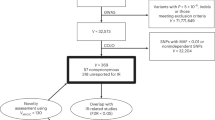Abstract
In a cross-sectional epidemiological study including 3290 men aged 53–75 y, mean=63, we tested the hypothesis that the Lewis phenotype Le(a−b−) is a genetic marker of obesity. All men were Lewis typed and measurements were made of height, weight, neck circumference, and hip fat fold. Obesity was defined as a body mass index ≥30 kg/m2. Totally 291 men (8.8%) were obese; 9.6% of the men had the Le(a−b−) phenotype. Le(a−b−) men had a higher prevalence of obesity than others, 15.6 vs 8.1%, odds ratio (95% confidence interval): 2.1(1.5–2.9), P<0.001. The etiological fraction, that is, the excess prevalence of obesity in the study population due to the Le(a−b−) phenotype, was approximately 10%. The frequency of the Le(a−b−) phenotype may vary substantially in different populations. Identification of this new genetic marker of obesity may, for example, contribute to the explanation of individual and ethnic differences in the prevalence of obesity.
This is a preview of subscription content, access via your institution
Access options
Subscribe to this journal
Receive 12 print issues and online access
$259.00 per year
only $21.58 per issue
Buy this article
- Purchase on Springer Link
- Instant access to full article PDF
Prices may be subject to local taxes which are calculated during checkout

Similar content being viewed by others
References
Mourant AE, Kopec AC, Damaniewska-Sobczak K . The Distribution of the Human Blood Groups and Other Polymorphisms. Oxford University Press: London; 1976.
Salomaa V, Pankow J, Heiss G, Cakir B, Eckfeldt JH, Ellison RC, Myers RH, Hiller KM, Brantley KR, Morris TL, Weston BW . Genetic background of Lewis negative blood group phenotype and its association with atherosclerotic disease in the NHLPI Family Heart Study. J Int Med 2000; 247: 689–698.
Hein HO, Sørensen H, Suadicani P, Gyntelberg F . The Lewis blood group—a new genetic marker of ischaemic heart disease. J Int Med 1992; 232: 461–487.
Suadicani P, Hein HO, Gyntelberg F . Weight changes and risk of ischaemic heart disease for middle aged and elderly men. An 8-year follow-up in the Copenhagen Male Study. J Cardiovasc Risk 1997; 4: 25–32.
Hein HO, Suadicani P, Sørensen H, Gyntelberg F . Alcohol consumption, Lewis phenotypes, and risk of ischaemic heart disease. Lancet 1993; 341: 392–396.
Hein HO, Suadicani P, Gyntelberg F . Lewis phenotypes, leisure time physical activity, and risk of ischaemic heart disease: an 11 year follow up in the Copenhagen male study. Heart 2001; 85: 159–164.
Petit JM, Morvan Y, Mansuy-Collingnon S, Viviani V, Vaillant G, Matejka G, Aho S, Guingier F, Brun JM . Hypertryglyridaemia and Lewis (a−b−) phenotype in non-insulin-dependent diabetic patients. Diabetes Metab 1997; 23: 202–204.
Clausen J, Hein HO, Suadicani P, Gyntelberg F, Pedersen O . Lewis phenotypes and the insulin resistance syndrome in young healthy white men and women. Am J Hypertens 1995; 11: 1060–1066.
Gyntelberg F . One- and two-years incidence of myocardial infarction in Copenhagen males aged 40–59. Dan Med Bull 1975; 22: 81–84.
Norusis M, SPSS Inc.. SPSS for Windows Base System User's Guide. Release 7.5, Chicago, IL, USA 1997.
Norusis M, SPSS Inc.. SPSS Professional Statistics 7.5, Chicago, IL, USA 1997.
Skov F, Eriksen M, Hagerup L . Distribution of the ABO, MNS, P, Rhesus, Lutheran, Kell, Lewis, and Duffy blood groups and frequency of irregular red cell antibodies in a population of Danes aged fifty years and a population of Danes aged seventy years. From the Glostrup population studies. Acta Path Microbiol Scand B Microbiol Immunol 1970; 78: 553–559.
Acknowledgements
This study received grants from The King Christian X's Foundation, The Danish Medical Research Council, The Danish Heart Foundation and The Else & Mogens Wedell-Wedellsborg Foundation.
Author information
Authors and Affiliations
Consortia
Corresponding author
Rights and permissions
About this article
Cite this article
Hein, H., Suadicani, P., Gyntelberg, F. et al. The Lewis blood group—a new genetic marker of obesity. Int J Obes 29, 540–542 (2005). https://doi.org/10.1038/sj.ijo.0802923
Received:
Accepted:
Published:
Issue Date:
DOI: https://doi.org/10.1038/sj.ijo.0802923
Keywords
This article is cited by
-
Lewis and AB0 blood group-phenotypes in periodontitis, cardiovascular disease, obesity and stroke
Scientific Reports (2019)



